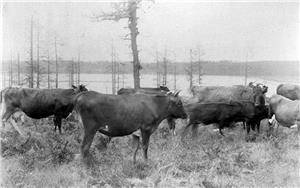On March 9, 1891, the Washington State Legislature approves the Puyallup Agriculture Experiment Station. It will be part of the new State College of Washington in Pullman. It becomes a reality in 1894, thanks to the foresight and generosity of Puyallup Valley farmers Darius M. Ross and his son, Charles. Their contribution of 40 acres (20 acres from each), plus the sale to the state of another 20 acres, provides the start for what will become the WSU Puyallup Research and Extension Center, a 360-acre research institute whose faculty, staff, and graduate students from 11 academic departments examine biological, environmental, and social issues far beyond the visions of its founders.
Scientific Farming and Home Economics
When the state Legislature created what became Washington Agricultural College, it specified experiment stations for both Eastern and Western Washington. Darius Ross was member of the state Board of Horticulture and, when the college was being created, the board lobbied for a research station specifically attuned to the needs of Western Washington farmers. Darius and Charles offered 40 acres -- 20 acres each -- for the station. College President E. A. Bryan visited the property and "asked for an additional 20 acres, which Darius offered for $3,500, considerably under the market even for those days" (Price and Anderson, p. 146). The state Legislature budgeted $2,500 for the purchase, the Tacoma Board of Trade volunteered $1,000, and ground was broken in 1894 for what was called "Ross Station."
The station's first few years were difficult. The parcel had been logged, but huge stumps remained, and they had to be blasted out. The station closed in 1897 when the Legislature declined to appropriate money for it, reopened in 1899, closed again in 1903, and finally reopened for good in 1907 as the Western Washington Experiment Station. "By 1913, the station had grown to a staff of five professionals, who not only conducted research, but who reached out to the remotest communities with agricultural and home economics information" (Price and Anderson, p. 147).
Dairy and Poultry
The station in 1916 opened a Winter School for instruction in dairy and poultry husbandry, berries, orchards, and nutrition. The poultry husbandry was pioneered by George Shoup and his wife, self-taught poultry specialists, and they laid the foundation for the state's poultry and egg industry.
In 1919, an $800,000 grant allowed the station to purchase 60 acres, a diary barn, and a dairy herd. J. W. Kalkus, the station's superintendent from 1926 to 1953, expanded its scope and instituted a research program in addition to extension services. Kalkus, a veterinarian, experimented with adding iodine to livestock feed. "His work contributed to the value of placing iodine in table salt to ward off human goiters" (Price and Anderson, p. 147).
The Washington Agricultural Experiment Stations were integrated into a newly established Institute of Agricultural Sciences at WSU, which included the College of Agriculture, the College of Veterinary Medicine, and the Agricultural Extension Service.
Innovative Plants and Programs
In the last half-century, the station has continued to expand its scope. Turf grass, for instance, which covers more acres than any other crop in Western Washington, was added as a program in 1956. Christmas trees and poplars are among the new crops.
In addition to research on crops and agricultural industries old and new, the station has reached out with programs on food and nutrition education for low-income families, organic farming, and studies on greenhouse gases. (Greenhouse gasses are chemical compounds in the atmosphere that allow the sun's rays to pass freely through. The rays reflect off the earth back into the atmosphere and the greenhouse gasses keep their heat from escaping into space. Some, like water vapor and carbon dioxide, occur in nature and others, like gasses used for aerosols, are human-made.)
The Master Gardener Program, launched in September 1972, is one of the station's most heralded developments. Volunteers are trained to answer questions and provide demonstrations in home gardening and related subjects and the program has been copied in more than 40 other states. Its website (http://gardening.wsu.edu) offers an exhaustive range of information on everything from Basic Gardening Skills to Berries, Grapes, and Kiwi.

